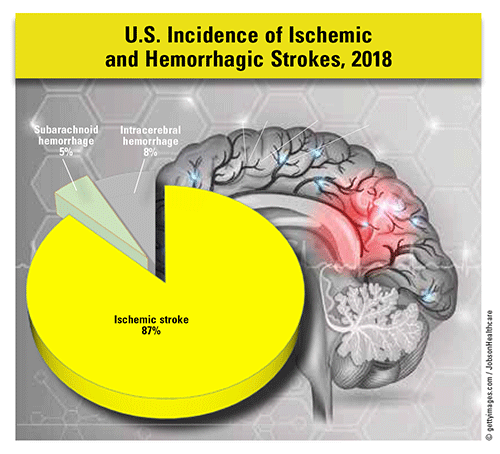US Pharm. 2021;46(1):14.
Each year, nearly 800,000 Americans suffer a stroke. This disorder, which is the fifth leading cause of death, has a mortality rate of 45.2 per 100,000 population. In 2009, 34% of persons hospitalized for stroke were younger than age 65 years. Annually, according to the National Institute of Neurological Disorders and Stroke, 160,000 people die of stroke-related causes in the United States. The CDC reports that in 2018 approximately 3% of adults (7.8 million) had ever had a stroke, and that as a primary diagnosis stroke generated 2.2 million physician office visits and 492,000 emergency-department (ED) visits. Cerebrovascular disease and history of stroke or transient ischemic attack (TIA) constituted 3.2% of chronic conditions recorded during ED visits in 2017.

Types of Stroke: Ischemic stroke is the most common form of this neurologic and cardiovascular disorder. Atrial fibrillation is a risk factor for ischemic stroke. Spontaneous, nontraumatic intracerebral hemorrhage causes stroke in 10% of cases, and subarachnoid hemorrhage causes stroke in 3% of cases. It has been reported that 38.5% of hemorrhagic strokes are subarachnoid, and the remaining 61.5% are intracerebral. All of these types of stroke are considered a life-threatening emergency.
Stroke Prevalence: In the U.S., 87% of strokes are ischemic and 13% are hemorrhagic; 75% of events are the first stroke experienced. Among patients recovering from a first stroke, 33.3%, 25%, and 3% will have another stroke within 2 years, 5 years, and 30 days, respectively. With age progression, the 10-year probability of stroke increases, with the likelihood greater in men (increasing from 5.9% in those aged 55-59 years to 22.3% in those aged 80-84 years) than in women (from 3% in those aged 55-59 years to 23.9% in those aged 80-84 years). However, the difference between men and women narrows notably with age progression, from 96.6% in persons aged 55 to 69 years to 16.1% in those aged 80 to 84 years.
Risk Factors: Approximately 33% of persons who have a TIA have a high probability of suffering a future stroke, with a majority occurring within 1 year of a TIA and 10% to 15% within 3 months of one. Modifiable risk factors for stroke include hypertension, hypercholesterolemia, heart disease, diabetes, smoking, and high alcohol intake. An estimated 75% of strokes are due to modifiable factors that are behavioral (e.g., smoking, poor diet, physical inactivity). An estimated 45% of all strokes in patients treated for hypertension may be attributable to uncontrolled blood pressure. In men, risk factors for stroke include obesity (75%), insufficient exercise (33.3%), smoking (16.7%), and diabetes (11.1%).
The content contained in this article is for informational purposes only. The content is not intended to be a substitute for professional advice. Reliance on any information provided in this article is solely at your own risk.
To comment on this article, contact rdavidson@uspharmacist.com.





